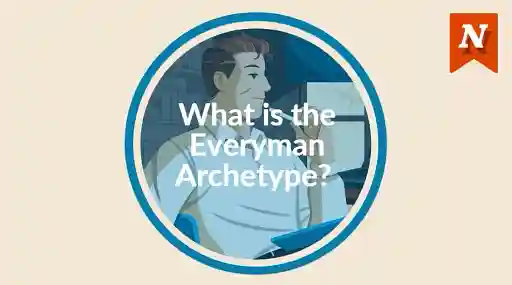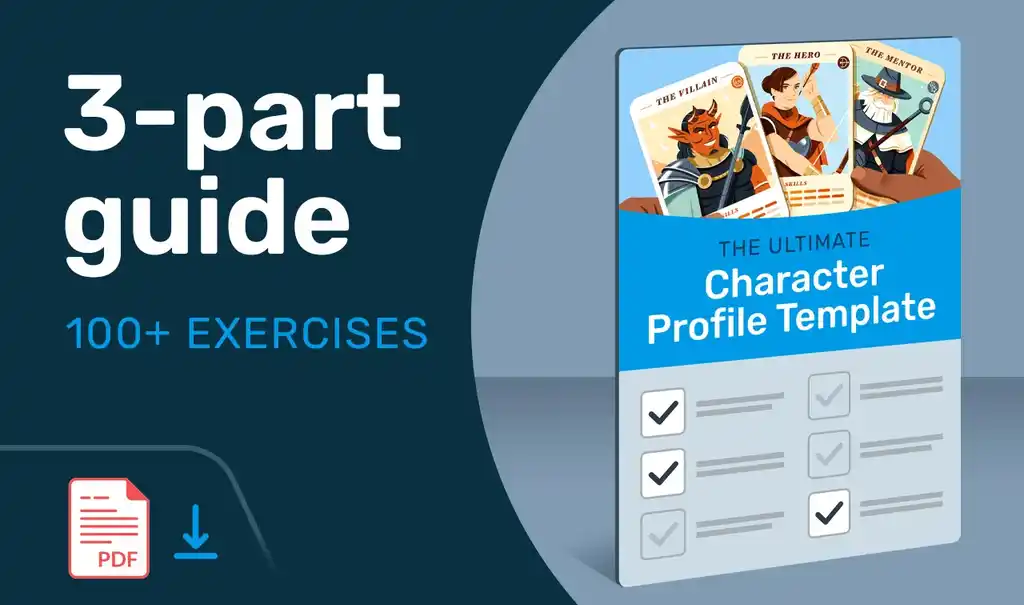Great characters, like people, are made up of many complex components that form a believable whole. From appearance to personality traits to speech patterns, the best character descriptions focus on specific details that both set them apart and make them feel like they could be your neighbor.
In this article, I’ll take a look at seven essential character description techniques, as well as some illustrative examples from literature, TV, and movie. I hope all this gives you some inspiration for how to write multi-dimensional characters yourself.
❗Before you start, consider creating a character profile. You’ll need to know your character well in order to write them in a way that feels authentic and original! Once you have that ready, let’s dive in.
1. Describe the character’s appearance
The first thing that comes to mind when you think about character description is probably physical appearances — hair, body composition, age, clothing style, etc. This is an important aspect of any person, real or fictional, as physical markers can reveal elements of culture, values, and how someone lives from day-to-day.
That said, too much focus on the outside can quickly become cliché and predictable. So how do you balance this as a writer?
Cut to the chase
Appearances are a good opportunity to help your reader quickly understand the character they’re dealing with. Rather than spending a whole paragraph describing what they look like, cut straight to the chase so that you can spend more of your time developing their internal worlds.
Character description example: Emily Henry's physical description of Augustus Everett in Beach Read.
“He looks exactly like the kind of guy you’d expect to see in a literary novel. Tall, dark, and brooding—he has a shadow of stubble on his chin, and his hair’s a little too messy in the way that makes it look like he doesn’t care but also knows it looks good.”
Not only does this description capture Augustus’ appearance in two sentences, but it also hints at his “brooding” personality — allowing readers to fill in the rest. If that weren’t enough, the evocative writing contributes to the overall self-aware, tongue-in-cheek tone of this popular rom-com, poking fun at the trope of the “tall, dark, and brooding” love interest.
Focus on specific details
Henry’s description of Augustus works so well because it hones in on a couple evocative details rather than trying to paint an exact picture of the character. So instead of listing a set of generic, physical characteristics (“blonde hair, blue eyes, medium build”), think about what specific detail(s) you can highlight to set your character apart from others.
Character description example: In The Blind Assassin, the narrator opens the story by remembering her sister, Laura, after her death.
“I could picture the smooth oval of Laura's face, her neatly pinned chignon, the dress she would have been wearing: a shirtwaist with a small rounded collar, in a sober colour - navy blue or steel grey or hospital-corridor green. Penitential colours - less like something she'd chosen to put on than like something she'd been locked up in.”
Atwood's description is specific in detail, giving clues to Laura's personality. From the “sober” and “penitential” colors of her clothes, we get a sense of her severe and depressive personality — important details to understand both the narrator and Laura as the story progresses.
Let the outside reflect the inside
While readers want to know some surface-level details about your character, appearance-based descriptions should never be just about the surface. They should also offer insight into the character's personality, backstory, and emotional state.
Perhaps they always have dirt under their fingernails because they work in landscaping, or maybe they have a scar on their forehead from a traumatic childhood event. Whatever the detail, it should be relevant to the story and/or help readers understand your character better.
Character description example: Miss Havisham in Great Expectations by Charles Dickens.
“Her hair was white and she had a pale, almost ghostly, appearance. She sat in a chair, with her wedding dress still on, rotting away as she herself had done, with all the paraphernalia of her wedding in a decaying state.”
This description perfectly balances surface-level description (white hair, pale complexion) with details that reveal something about who the character is. Miss Havisham’s attire and the paraphernalia symbolise her inability to move on from her past — specifically, her traumatic wedding day.
Now, moving past looks, another thing that defines characters is their actions.
2. Show their personality through action
One of the best ways to show who a character is is to let their actions speak for themselves. After all, actions speak louder than words, so use your character’s behaviour to reveal their personality, emotions, values, and motivations.
Link behaviour to personality
Rather than saying that your character has an “anxious” or “kind” personality, try to think of ways that you can show these traits through habits or mannerisms.
Maybe they always fidget, or maybe they always stop to help old ladies cross the road. These types of details will help you show, rather than tell, what your character is like and how they move through the world.
Character description example: Virginia Woolf hints at Mrs Ramsey’s personality in this subtle scene in To the Lighthouse.
“She rose to her feet and moved towards the window. She opened the window with a decisive gesture, and for a moment stood looking out at the view.”
Set in the Ramsey family’s summer home, Mrs. Ramsey is an accomplished matriarch and hostess. In this scene, however, Mrs. Ramsay’s actions reveal that she is more than these things; there is also a sense of internal longing and complexity beneath her domestic duties.
Or relate it to their background
You can also tie current behaviour together with past experiences to give your character greater depth.
Character description example: In her novel Jazz, Nobel laureate Toni Morrison takes her time to show the character of Violet in action.
“I know that woman. She used to live with a flock of birds on Lenox Avenue. Know her husband, too. He fell for an eighteen-year-old girl with one of those deepdown, spooky loves that made him so sad and happy he shot her just to keep the feeling going.
When the woman, her name is Violet, went to the funeral to see the girl and to cut her dead face they threw her to the floor and out of the church. She ran, then, through all that snow, and when she got back to her apartment she took the birds from their cages and set them out the windows to freeze or fly, including the parrot that said, 'I love you.'”
Morrison doesn't say: “Violet was driven crazy by grief, even to the point of disfiguring a dead girl, when her lover cheated on her.” Instead, she shows Violet acting out the extreme manifestations of her grief.
Establish habits and mannerisms
Special traits or habits are another way to make characters come alive on the page. These subconscious behaviors can act as a window into their minds.
Character description example: In Normal People by Sally Rooney, Connell’s habits of pushing hair out of his face and avoiding eye contact enforce his uncertain disposition.
“Connell’s movements were always hesitant, like he wasn’t sure where he belonged in a room. He’d often look down, pushing his hair out of his face with a quick gesture, but never holding anyone’s gaze for too long.”
Next, to give some depth to your character, let’s look at beliefs and motivations.
3. Reveal their beliefs and motivations
To truly ground your character in reality, give them a strong set of beliefs and motivations. These will allow readers to understand why they act the way they do and, ultimately, who they are.
Let’s look at how to capture this in your character descriptions.
Connect motivations to core values
To create compelling and realistic characters, it's important to implicitly and/or explicitly establish some core values.
Character description example: Take this simple sentence from To Kill a Mockingbird.
“Atticus did not fear the anger of the community, for he had faith in the courts to deliver justice.”
In just one sentence, Harper Lee establishes one of Atticus’ key beliefs: that the legal system should uphold justice for all. This belief informs all of his subsequent actions, explaining his calm demeanor, and providing him with a moral compass that allows him to go against his community when he thinks the community is wrong.
Have them prioritise one thing above all others
Character description example: Another example is Vianne Mauriac in Kristin Hannah’s The Nightingale.
“Vianne Mauriac was a mother. It was her job, her reason for being, and she would do whatever it took to protect her daughter.”
Set in France during WWII, Vianne is motivated by her intense love for her daughter. She holds the belief that she must keep her head down in order to survive. This causes her to compromise her own principles and turn a blind eye to the harsh realities of the German occupation — but as the novel progresses, she realizes that survival at all costs is not enough.
Give your characters some false beliefs, too
As we can see in the example of Vianne, characters often have a flawed idea of what they want or need to achieve in order to reach their goal. No character is perfect, so giving them this kind of “flaw” can make them feel more real.
Character description example: Elizabeth Bennet in Pride and Prejudice holds the false belief that Mr. Darcy is prideful and arrogant, and that marriage to him would lead to great unhappiness, causing her to reject his sincere proposal.
Another part of (indirect) character description is speech.
4. Capture how they speak and interact
Describing characters through conversation is another way to make them feel like real people. What they say, how they say it, and how they interact with others can offer profound insights into a character’s psyche and inclinations.
Establish your character’s voice
Word choice, tone, and style of speech can hint at your character’s social status, intellect, and emotional complexity without explicitly stating it.
Character description example: In Circe, Madeline Miller captures the personality of the eponymous protagonist in the following quote.
“I never seemed to belong anywhere. Always an outsider, I learned to speak with the softest of voices, knowing that I would be heard by no one, until I found a way to make them listen.”
It is clear from this description that Circe is not just a passive, meek character who happens to be soft-spoken; instead, she is perceptive and has learnt to adjust to her circumstances. But she also has a calculating nature, biding her time until the day when people can’t ignore her voice. Through this type of character description, the reader understands the silent rage bubbling under Circe’s calm demeanor.
Juxtapose what is said with what is done
Human beings are full of contradictions, and often say one thing but do another. Dialogue is a perfect opportunity to capture this.
Character description example: In Franny and Zoey, J.D. Salinger juxtaposes what is said between characters Lane and Franny with how each character feels.
“He suddenly leaned forward, putting his arms on the table, as though to get this thing ironed out, by God, but Franny spoke up before he did. 'I'm lousy today,' she said. 'I'm just way off today.'
She found herself looking at Lane as if he were a stranger, or a poster advertising a brand of linoleum, across the aisle of a subway car.”
Both characters are feeling frustrated, as we can tell from their actions and feelings — but the dialogue never fully expresses this frustration. This creates a layered interaction where both characters seem to have rich inner lives, but hold back in consideration of the other, or from an inability to express themselves fully.
Let characters describe themselves
How characters view themselves lends another clue to their personalities. You can reveal this either through dialogue or monologue.
Character description example: In Catcher in the Rye, Holden Caulfield speaks directly to the reader.
“I'm a madman, that's all. I don't even know why I'm mad, but I am. Maybe it’s because I’m a phony, but who the hell wants to be a phony?”
First-person narration or dialogue where a character describes themselves can be revealing in a few different ways. Firstly, as Holden describes himself as a madman and phony — which may or may not be true — it gives the reader insight into his self-image.
Secondly, through his brash and blustering speech, we get insight into his personality. Taken all together, this passage says less about whether he’s a madman or phony; rather, it paints an image of a self-aware, cynical, and somewhat rebellious teen who isn’t afraid to be provocative.
On a related note, you can also use other characters to describe your character — which is what we’ll look at next.
5. Let other characters describe them
Using multiple perspectives in your story — whether through dialogue or whole sections dedicated to different POVs — can add depth and complexity to characters and their relationships.
People rarely go around describing themselves, and even when they do, their self-perception is not always accurate. So having characters describe each other can be a great way to make your character description more “organic”.
Character description example: Virginia Woolf is a master of combining multiple characters' points of view (even within a single scene) to create a complex sense of ensemble and emotion. In this scene from To the Lighthouse, Charles Tansley is described by multiple characters at once:
“[Mrs. Ramsay] looked at him. He was such a miserable specimen, the children said, all humps and hollows. He couldn't play cricket; he poked; he shuffled. He was a sarcastic brute, Andrew said. They knew what he liked best - to be for ever walking up and down, up and down, with Mr. Ramsay, saying who had won this, who had won that …”
We see a clear sense of the children's dislike, and of how Tansley looks through their eyes, as observed by their mother. Further on, Mrs. Ramsay notes Tansley's pompous and academic way of speaking — Tansley is actually from a working-class background and wishes to impress the Ramsays, but backfires in his zealotry.
Shortly after the above description, Woolf switches to Tansley's point of view and we get a more romantic sense of Tansley and how he sees things (and how he views Mrs Ramsay herself):
“... and all at once he realised that it was this: - she was the most beautiful person he had ever seen.
With stars in her eyes and veils in her hair, with cyclamen and wild violets - what nonsense was he thinking? She was fifty at least; she had eight children.”
Woolf combines concise, clear physical description (“all humps and hollows”) with a deeper sense of personality. We see “boring”, academic, and non-sportsman Tansley, but also Tansley's romantic dreamer side through his own POV. In this way, Woolf makes Tansley (and other characters) multi-dimensional and full of human contradictions.
6. Use metaphors to deepen character description
Many character descriptions use literary devices like metaphor and similes to build vivid character.
Personify emotions (and other potent qualities)
Character description example: In Arundhati Roy's The God of Small Things, the character Estha retreats inwards and stops talking in the wake of a traumatic experience. Roy's use of metaphor in this character description example is much more effective than if she were to say Estha is “sad” or “traumatized”.
“Once the quietness arrived, it stayed and spread in Estha. It reached out of his head and enfolded him in its swampy arms...sent its stealthy, suckered tentacles inching along the insides of his skull, hoovering the knolls and dells of his memory, dislodging old sentences, whisking them off the tip of his tongue.”
By describing Estha's silence as a parasitic, living creature eating away at her, Roy conveys Estha's suffering while avoiding emptier, more abstract terms.
Make use of extended metaphors
The Victorian author Charles Dickens was also a master of characterization, and often used extended metaphor when introducing characters.
Character description example: Here, Dickens describes the boastful, self-important Mr. Bounderby in Hard Times.
“He was a rich man: banker, merchant, manufacturer, and what not. A big, loud man, with a stare, and a metallic laugh. A man made out of coarse material, which seemed to have been stretched to make so much of him [...] always proclaiming, through that brassy speaking-trumpet of a voice of his, his old ignorance and his old poverty.”
Dickens drives this generally unpleasant description home with the picture of Mr. Bounderby as a “man made out of coarse material, which seemed to have been stretched.” These details combined create a clear sense of his persona.
Lastly, let’s look at how you can also capture your character by showing what they are not.
7. Compare and contrast characters
Each major character should have their own voice, appearance, world view and set of motivations — but many writers struggle to make them distinct from each other. One simple way to combat this is to establish a contrasting (or “foil” character) who acts as a counterpoint, representing what your character is not.
Character description example: George Eliot clearly differentiates the two sisters who are first introduced in Middlemarch. We meet pious Dorothea and her younger sister, the more worldly, materialistic Celia.
“The rural opinion about the new young ladies, even among the cottagers, was generally in favour of Celia, as being so amiable and innocent-looking, while Miss Brooke's large eyes seemed, like her religion, too unusual and striking. Poor Dorothea! Compared with her, the innocent-looking Celia was knowing and worldly-wise.”
Because Dorothea's pious nature is crucial for Eliot's plot, the foil of her “worldly-wise” sister draws our attention to this important character trait from the start.
I hope that with these specific techniques and character description examples, you have a better sense of how to write your own wonderfully complex, authentic characters that leap off the page! When in doubt, choose specifics over generalities; show their behaviour rather than “telling” it; and weave your descriptions into the story through dialogue and other characters. Happy writing!












Although unfamiliar with your choices, barring Dickens and George Eliot, I like the idea of stealing character traits from authors I do read. It would be a privilege if one of them read my work and complained. Possible as I don't read work tagged, "award-winning."
Bob Fairfield - Almost 9 years ago
Hi Bob - any particular reason for this blanket ban? It's true that whether or not a book has won an award isn't always a reliable marker of the quality of its storytelling. Thanks for weighing in.
Bridget At Now Novel - Almost 9 years ago
I have always been disappointed by the award winning novels and cannot fathom the reason for the choices, culminating in my absolute hatred of Mantel's overblown ego trip, " Bring up the bodies."
Bob Fairfield - Almost 9 years ago
It's true that taste is a fairly subjective thing.
Bridget At Now Novel - Almost 9 years ago
I like your blog more and more. It is very useful! I think pretty often I use comparison to describe my characters.
Melissa Roscoe - Almost 9 years ago
Thanks, Melissa. It is a useful means for drawing out differences and defining attributes.
Bridget At Now Novel - Almost 9 years ago
Hi, just had a book beta read, and the reader suggested more character descriptions. I've always been weak with that, and in doing research came across this article. It's interesting. I'm not for the narrative description of Dickens, makes me retch. The whole show don't tell thing. I know it's a fine line, but those examples of 1-4 are that to me. I'm glad you hit the many varieties. 5, 6 & 7 are more my style. Thanks for highlighting the different options. I've bookmarked this article for future reference.
Dune Games - Over 6 years ago
Hi Dune, That's a pity, Dickens' characterization is so vivid if you can look past his Victorian/fussy prose style. I'm glad you liked the latter more action-based examples. Thanks for reading and sharing your perspective :)
Jordan At Now Novel - Over 6 years ago
chicken nuggets are good.
Max F. - Almost 4 years ago
Some characters even troll with comments about chicken nuggets on writing blogs :) There's room for every type.
Jordan - Almost 4 years ago